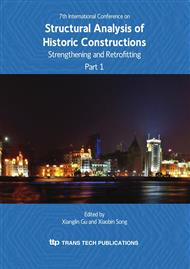[1]
Allemang, R J (2003). The modal assurance criterion - Twenty years of use and abuse., Sound and Vibration, August, 14-21.
Google Scholar
[2]
ATC (1996). Seismic evaluation and retrofit of concrete buildings., Report nº SSC 96-01, Applied Technology Council, ATC 40. Redwood City, California.
Google Scholar
[3]
Bairrão, R, and Falcão Silva, M J (2009). Shaking table tests of two different reinforcement techniques using polymeric grids on an asymmetric limestone full-scaled structure., Engineering Structures, 31(6), 1312-1330.
DOI: 10.1016/j.engstruct.2008.04.039
Google Scholar
[4]
Barbat, A H, and Pujades, L (2004). Vulnerability and risk seismic assessment in urban areas. Case study: Barcelona., in Proc. 6ESES, Guimarães, Portugal, 229-252. (in Spanish).
Google Scholar
[5]
Braga, F, Dolce, M, and Liberatore, D (1982). A statistical study on damaged buildings and an ensuing review of the MSK-76 scale., in Proc. 7ECEE, Athens, 431-450.
Google Scholar
[6]
Candeias, P (2009). Seismic Vulnerability assessment of ancient masonry buildings, PhD thesis, University of Minho, Guimarães, Portugal. (in Portuguese).
Google Scholar
[7]
Carvalho, E C (1998). Seismic testing of structures., in Proc. 11th European Conference on Earthquake, Paris, France.
Google Scholar
[8]
Coelho, E, Campos Costa, A, and Carvalho, E C (2000). Assessment of experimental seismic response through damage evaluation., in Proc. 12WCEE, Auckland, New Zealand.
Google Scholar
[9]
Corsanego, A, and Gavarini, C (1993). Ten years of research into the seismic vulnerability of constructions in Italy., [Online]. Available: http: /hdl. handle. net/2122/3596.
DOI: 10.4401/ag-4308
Google Scholar
[10]
Degée, H, Denoël, V, Candeias, P, Campos Costa, A, and Coelho, E (2007). Experimental investigation on the seismic behavior of North European masonry houses., in Proc. Sísmica2007, Porto, Portugal.
Google Scholar
[11]
EN 1998-1 (2004). Eurocode 8: Design of structures for earthquake resistance - General rules, seismic actions and rules for buildings., European Committee for Standardization.
DOI: 10.3403/03244372u
Google Scholar
[12]
Giovinazzi, S and Lagomarsino, S (2003). Seismic risk analysis: a method for the vulnerability assessment of built-up areas, in Proc. European Safety and Reliability Conference, Maastricht.
Google Scholar
[13]
Grünthal, G (1998). European Macroseismic Scale 1998., Cahiers du Centre Européen de Géodynamique et de Séismologie, volume 15, Luxemburgo.
Google Scholar
[14]
Krämer, C, Smet, C A M and Peters, B (1999). Comparison of ambient and forced vibration testing of civil engineering structures, in Proc. MAC XVII, Kissimmee, FL, USA.
Google Scholar
[15]
Mendes, N and Lourenço, P B (2010). Seismic assessment of masonry "gaioleiro" buildings in Lisbon, Portugal., Journal of Earthquake Engineering, 14(1), 80-101.
DOI: 10.1080/13632460902977474
Google Scholar
[16]
Mendes, N, Lourenço, P B, and Campos Costa, A (2010). Identification test of the dynamic properties of an experimental masonry model., accepted for publication in Proc. CNME 2010, Guimarães, Portugal. (In Portuguese).
Google Scholar
[17]
Palacios, S M (2004). State of the art in seismic vulnerability., Institutional repository of Alicante University. [Online]. Available: http: /hdl. handle. net/10045/2626.
Google Scholar
[18]
Sousa, M L (2006). Seismic risk in Mainland Portugal., PhD thesis, Instituto Superior Técnico (IST), Lisbon, Portugal.
Google Scholar


